Intel Core i7 3820 Review: $285 Quad-Core Sandy Bridge E
by Anand Lal Shimpi on December 29, 2011 2:28 AM EST- Posted in
- CPUs
- Intel
- Sandy Bridge
- Sandy Bridge E
If you are a normal desktop user or even a power user with plans to run at over 4GHz, the vanilla LGA-1155 Sandy Bridge platform is good enough. You get some of the fastest CPUs on the market today paired with reasonably priced motherboards and the ability to use Quick Sync to transcode video...er...quickly. If that's not enough, Intel launched a higher end platform last month: the LGA-2011 Sandy Bridge E.
Take a regular Sandy Bridge, add PCIe 3.0 support, increase the number of PCIe lanes that branch off of the CPU (from 16 to 40 lanes), double the number of memory channels (4 x 64-bit DDR3 memory controllers) and you've got Sandy Bridge E and its LGA-2011/X79 platform. SNB-E is currently available in two forms: a $999 6-core Extreme Edition part (Core i7 3960X) and a $555 6-core unlocked version (Core i7 3930K). Neither is exactly cheap but if you need the PCIe lanes, core count and memory bandwidth, they are your only ticket.
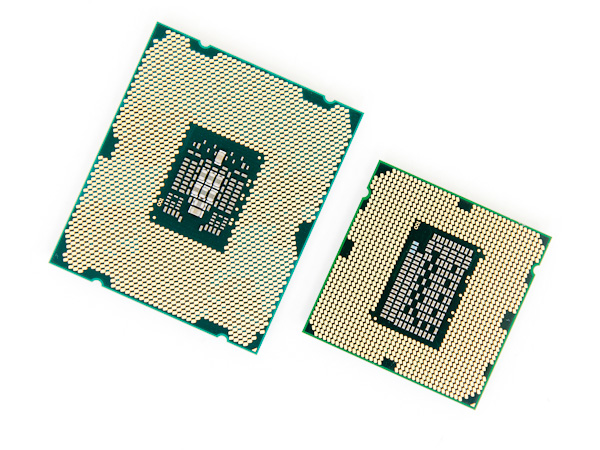
LGA-2011 SNB-E (left) vs. LGA-1155 SNB (right)
Sandy Bridge E is a fairly niche platform to begin with, but what about the niche within the niche (extremeception?) of users who just need the LGA-2011 platform but not necessarily a 6-core behemoth? For those users, there's the Core i7 3820:
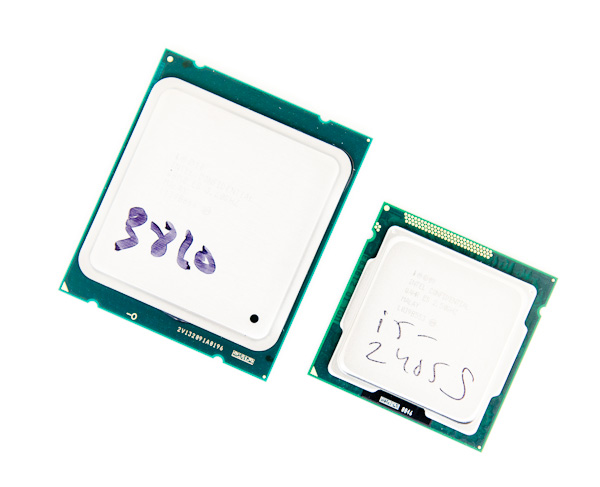
LGA-2011 SNB-E (left) vs. LGA-1155 SNB (right)
The Core i7 3820 is the first (and only) quad-core Sandy Bridge E CPU. It's so new that the chip isn't even available for sale nor will it be until early 2012. Unlike the relationship between the 3960X and 3930K, the 3820 is an entirely new die.
The chip features four Sandy Bridge cores and is paired with a 10MB L3 cache, giving it a slight advantage over the highest end LGA-1155 Sandy Bridge CPUs on the market today. The result is a die that's bigger than a regular SNB but significantly smaller than a 6-core SNB-E:
| CPU Specification Comparison | ||||||||
| CPU | Manufacturing Process | Cores | Transistor Count | Die Size | ||||
| AMD Bulldozer 8C | 32nm | 8 | 1.2B | 315mm2 | ||||
| AMD Thuban 6C | 45nm | 6 | 904M | 346mm2 | ||||
| AMD Deneb 4C | 45nm | 4 | 758M | 258mm2 | ||||
| Intel Gulftown 6C | 32nm | 6 | 1.17B | 240mm2 | ||||
| Intel Sandy Bridge E (6C) | 32nm | 6 | 2.27B | 435mm2 | ||||
| Intel Sandy Bridge E (4C) | 32nm | 4 | 1.27B | 294mm2 | ||||
| Intel Nehalem/Bloomfield 4C | 45nm | 4 | 731M | 263mm2 | ||||
| Intel Sandy Bridge 4C | 32nm | 4 | 995M | 216mm2 | ||||
| Intel Lynnfield 4C | 45nm | 4 | 774M | 296mm2 | ||||
| Intel Clarkdale 2C | 32nm | 2 | 384M | 81mm2 | ||||
| Intel Sandy Bridge 2C (GT1) | 32nm | 2 | 504M | 131mm2 | ||||
| Intel Sandy Bridge 2C (GT2) | 32nm | 2 | 624M | 149mm2 | ||||
There's a small improvement in base clock frequency over the fastest SNB (3.6GHz vs. 3.5GHz) but max turbo remains unchanged at 3.9GHz. For single threaded applications the 3820 should be just as fast as a Core i7 2700K or a 3960X. The same is true for if all heavily threaded workloads, at least when compared to other quad-core parts (the 3960/3930 still maintain an advantage because of their two additional cores).
| Processor | Core Clock | Cores / Threads | L3 Cache | Max Turbo | Max Overclock Multiplier | TDP | Price |
| Intel Core i7 3960X | 3.3GHz | 6 / 12 | 15MB | 3.9GHz | 57x | 130W | $990 |
| Intel Core i7 3930K | 3.2GHz | 6 / 12 | 12MB | 3.8GHz | 57x | 130W | $555 |
| Intel Core i7 3820 | 3.6GHz | 4 / 8 | 10MB | 3.9GHz | 43x | 130W | $285 |
| Intel Core i7 2700K | 3.5GHz | 4 / 8 | 8MB | 3.9GHz | 57x | 95W | $332 |
| Intel Core i7 2600K | 3.4GHz | 4 / 8 | 8MB | 3.8GHz | 57x | 95W | $317 |
| Intel Core i7 2600 | 3.4GHz | 4 / 8 | 8MB | 3.8GHz | 42x | 95W | $294 |
| Intel Core i5 2500K | 3.3GHz | 4 / 4 | 6MB | 3.7GHz | 57x | 95W | $216 |
| Intel Core i5 2500 | 3.3GHz | 4 / 4 | 6MB | 3.7GHz | 41x | 95W | $205 |
There's no on-die GPU, no heatsink/fan in the box and this isn't a fully unlocked part so the 3820 is actually cheaper than most of the high-end Sandy Bridge CPUs: it's priced at $285. If it weren't for the fact that you'll still need to spend over $200 on a motherboard I would say that the 3820 is a steal.
Overclocking
Let's start with the basics. All Sandy Bridge CPUs are clock locked by default, they can't operate at frequencies other than what they're sold at. There are two exceptions to this rule. All Sandy Bridge CPUs that support Turbo Boost are partially unlocked. Not only can they turbo up to frequencies that are higher than their default clock, but they can also be overclocked to frequencies even higher than their turbo speeds. By default, all Turbo enabled Sandy Bridge CPUs can be set to run at up to four bins (4 * bclk or 400MHz by default) higher than their standard turbo frequencies:
The second exception is any of the K or X-series SKUs. If your Sandy Bridge model number ends in a K or X, then the chip is fully unlocked and can be overclocked up to 5.7GHz using only clock multiplier adjustments.
The Core i7 3960X and 3930K fall into the latter category, which makes overclocking them a breeze. The 3820 on the other hand is partially unlocked, which means that we can run it at up to 4.3GHz using multiplier adjustments alone. Note that the 4.3GHz limit only applies to the 1-core active state, in the worst case scenario of all cores active with no room to turbo the highest operating frequency of the chip when overclocked would be 4.0GHz.
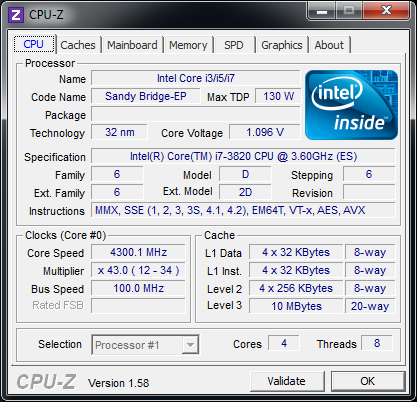
The max 3820 overclock without touching bclk settings
While these aren't bad targets, they're not all that exciting either. Thankfully Sandy Bridge E makes it even easier to overclock through the use of a few higher bclk frequencies. By default Sandy Bridge uses a 100MHz bclk, but SNB-E allows for 125MHz, 166MHz and 250MHz options as well. The 166/250MHz settings are a bit too aggressive, but the 125MHz bclk setting proved to be the perfect companion for the 3820.
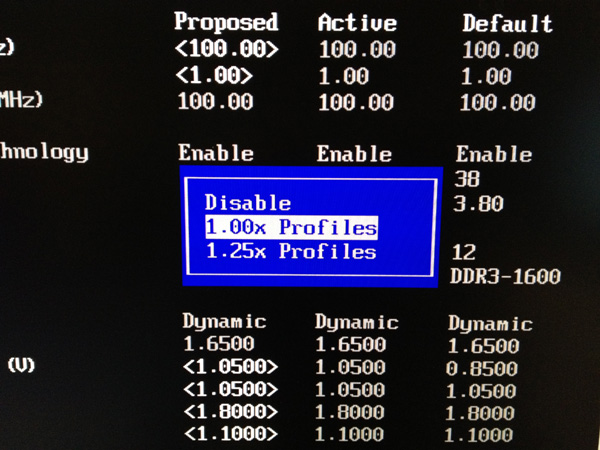
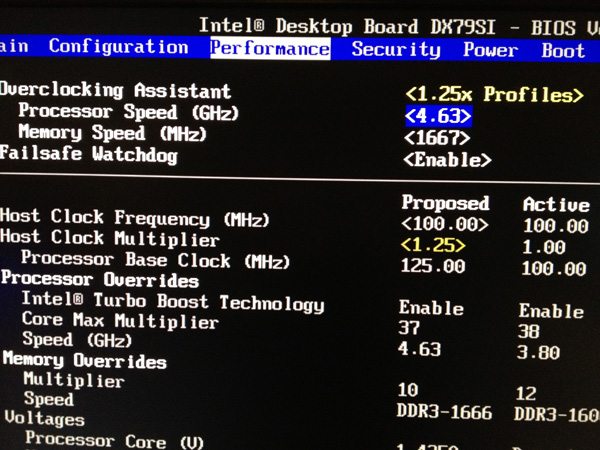
Intel's DX79SI makes it extremely easy to overclock, especially with the latest BIOS update. There are built in overclocking profiles for each bclk setting that you can choose from. I simply selected the 1.25x (125MHz) profile option and then went through the list of target frequencies until I found one that seemed promising. I also went in and tweaked some of the settings myself to get a bit more clock speed (4.63GHz is the fastest profile this board allows by default) and improve stability. In the end I was fairly pleased with what the 3820 could do: 4.75GHz with Intel's RTS2011LC closed loop cooling system.
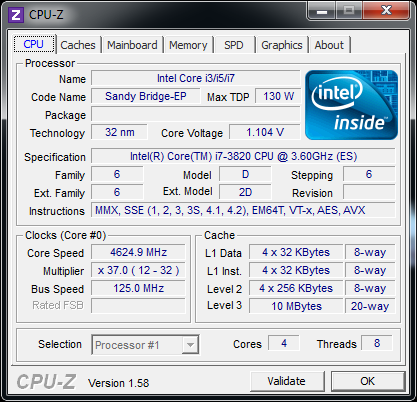
Now we're talking
I couldn't get the 3820 as stable as I would like at 4.88GHz and 5GHz was unfortunately out of the reach of my sample. I can't really complain about 4.75GHz from a $285 chip though, especially without resorting to anything too exotic from a cooling standpoint. Overclocking is also extremely effortless thanks to the new bclk options on SNB-E. Although the Core i7 3820 isn't an unlocked part, that doesn't limit how far (or how easily) it can be overclocked. A big part of the ease of overclocking is due to how good of a job Intel did on the DX79SI BIOS options, but from what we've seen the third party boards also do a decent job of simplifying the process.
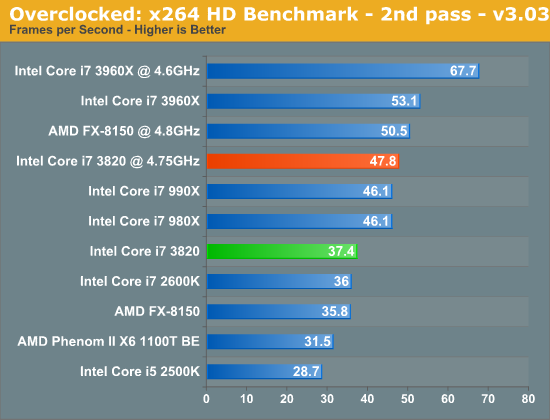
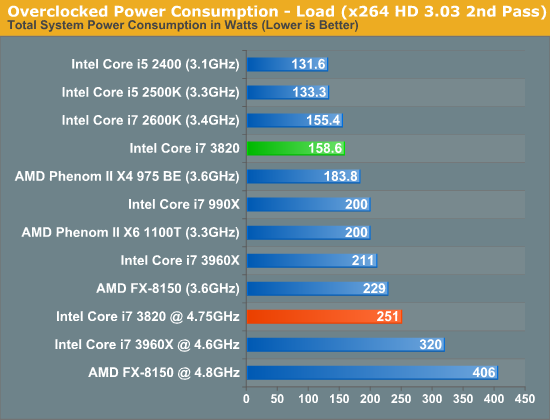
The Test
To keep the review length manageable we're presenting a subset of our results here. For all benchmark results and even more comparisons be sure to use our performance comparison tool: Bench.
| Motherboard: |
ASUS P8Z68-V Pro (Intel Z68) ASUS Crosshair V Formula (AMD 990FX) Intel DX79SI (Intel X79) |
| Hard Disk: |
Intel X25-M SSD (80GB) Crucial RealSSD C300 |
| Memory: | 4 x 4GB G.Skill Ripjaws X DDR3-1600 9-9-9-20 |
| Video Card: | ATI Radeon HD 5870 (Windows 7) |
| Video Drivers: | AMD Catalyst 11.10 Beta (Windows 7) |
| Desktop Resolution: | 1920 x 1200 |
| OS: | Windows 7 x64 |


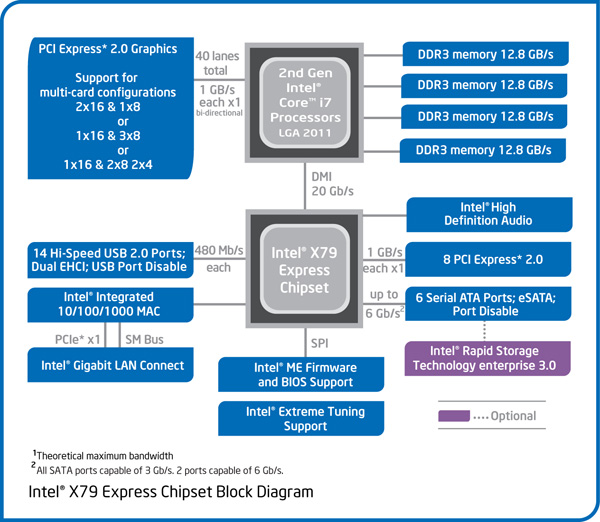









84 Comments
View All Comments
ytoledano - Thursday, December 29, 2011 - link
I'm in desperate need of memory. I bought the 3930K with 48GB as soon as it was released. If the 3820 was available then I would have gotten it and saved the cash for more memory. I guess this chip is useful for those just looking for SB-E features like 8 slot 4 channel memory or the PCI-E channels.Taft12 - Sunday, January 1, 2012 - link
One day guys like you will learn Xeon/Opteron workstation platforms exist and really aren't all that expensive.futurepastnow - Thursday, December 29, 2011 - link
#4: You need a new PC right now and can't afford a 6-8 core CPU but would like to upgrade later.hechacker1 - Thursday, December 29, 2011 - link
Somewhat true. I have an i7 920, and would love to upgrade to a Gulftown 6-core now that is considered old.However, the price isn't coming down. It seems to be stuck at around $550 despite lower priced 4 core processors performing better at low threaded benchmarks.
So it may make sense to just pay the price for the 6 core version if you really need it. Unless you are ready to go very long term in waiting for the price to come down.
I imagine when Ivy-E comes out (with 8 cores?) perhaps then the old 6-core processors will finally get real cheap.
piroroadkill - Monday, January 2, 2012 - link
Unlikely. This upgrade path is ridiculous - it gives you a 4 core CPU that is effectively a wasted investment, hoping that the 6 cores come down.Go check out the best CPUs in socket 775 - Q9550, Q9650, and maybe the fabled Q9550S with its lower TDP.
These things are still ridiculously expensive, and won't budge because people want the best on their old platform.
CW1 - Thursday, December 29, 2011 - link
"This also really provides that budget friendly high-end part for X79, basically the successor to the i7-920 for entry level enthusiasts. X79 still has its glaring omissions (USB 3.0, limited SATA6G, no Thunderbolt etc) but the 3820 makes it look better compared to SB and even IB."
The 3820 is essentially the Sandy Bridge's i7-920. With what benchmarks I can find, it appears the 2600 runs around 10% faster than the i7-920 and with the 3820 running a few % faster than the 2600, I just don't see good reason to upgrade my aging i7-920 just yet. Perhaps we can convince Anand to compare the i7-920 to the new 3820...
Sure, 32gb of memory would be great! The cost of that memory is a large page file size and a large hibernation size. Using recommended page file size, that's 64gb of precious SSD space!!
hechacker1 - Thursday, December 29, 2011 - link
I know it's possible to easily relocate the swap file, but I think you're right, you can't easily move the hiberfil.sys.But then I rarely hibernate my desktop PC. It goes into S3 sleep, which is IMHO, good enough. Unless you are prone to frequent power outages.
peterfares - Thursday, December 29, 2011 - link
Manually set the page file size then. There is no need to waste all that space on a page file that will rarely get used. I have 8GB in my laptop with a 128GB SSD. I set the page file to only 2GB.CW1 - Friday, December 30, 2011 - link
Yeah, that's why I said "recommended". Although I've got 12gb ram and still have my page size set to 12gb. When my SSD starts running low on space I'll shrink it down.You could relocate the pagefile to a differnet drive, but it's something you'd want on an SSD. :)
Regardless, Intel hasn't provided any real incentive to upgrade my i7-920. I was really hoping that SandyBridge-E would be my next upgrade (I've got the itch!), but it looks like Ivy Bridge will be it.
Unfortunately, this appears a result of no real competition for Intel other than within itself. There's nothing to push the price of performance down. AMD has become all but forgotten. Unless they make a big splash in the CPU market their market share will continue to dwindle. It's unfortunate...all my machines have switched to Intel...the last AMD was a x2 250 for my htpc. With Sandy Bridge, I finally upgraded that machine so I could use the onboard GPU.
dj christian - Thursday, January 5, 2012 - link
You shouldn't shrink the pagefile when your's SSD is running low on space. Trust me!